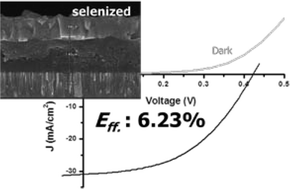A hybrid ink of binary copper sulfidenanoparticles and indium precursor solution for a dense CuInSe2 absorber thin film and its photovoltaic performance†
Abstract
A newly developed hybrid ink of binary CuS

* Corresponding authors
a
Department of Chemistry, Korea Advanced Institute of Science and Technology, Daejeon, Republic of Korea 305-701
E-mail:
hsong@kaist.ac.kr
b
Photovoltaic Center, Korea Institute of Energy Research, 102 Gajeong-ro, Yuseong-gu, Daejeon, Republic of Korea 305-343
E-mail:
y-kh@kier.re.kr
A newly developed hybrid ink of binary CuS

 Please wait while we load your content...
Something went wrong. Try again?
Please wait while we load your content...
Something went wrong. Try again?
A. Cho, S. Ahn, J. H. Yun, J. Gwak, H. Song and K. Yoon, J. Mater. Chem., 2012, 22, 17893 DOI: 10.1039/C2JM32624H
To request permission to reproduce material from this article, please go to the Copyright Clearance Center request page.
If you are an author contributing to an RSC publication, you do not need to request permission provided correct acknowledgement is given.
If you are the author of this article, you do not need to request permission to reproduce figures and diagrams provided correct acknowledgement is given. If you want to reproduce the whole article in a third-party publication (excluding your thesis/dissertation for which permission is not required) please go to the Copyright Clearance Center request page.
Read more about how to correctly acknowledge RSC content.
 Fetching data from CrossRef.
Fetching data from CrossRef.
This may take some time to load.
Loading related content
